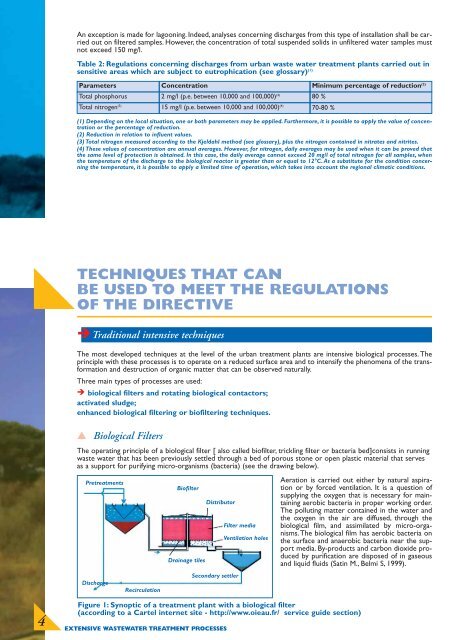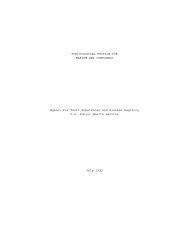Guide Extensive wastewater treatment process
Guide Extensive wastewater treatment process
Guide Extensive wastewater treatment process
Create successful ePaper yourself
Turn your PDF publications into a flip-book with our unique Google optimized e-Paper software.
4<br />
An exception is made for lagooning. Indeed, analyses concerning discharges from this type of installation shall be carried<br />
out on filtered samples. However, the concentration of total suspended solids in unfiltered water samples must<br />
not exceed 150 mg/l.<br />
Table 2: Regulations concerning discharges from urban waste water <strong>treatment</strong> plants carried out in<br />
sensitive areas which are subject to eutrophication (see glossary) (1)<br />
Parameters Concentration Minimum percentage of reduction (2)<br />
Total phosphorus 2 mg/l (p.e. between 10,000 and 100,000) (4) 80 %<br />
Total nitrogen (3) 15 mg/l (p.e. between 10,000 and 100,000) (4)<br />
70-80 %<br />
(1) Depending on the local situation, one or both parameters may be applied. Furthermore, it is possible to apply the value of concentration<br />
or the percentage of reduction.<br />
(2) Reduction in relation to influent values.<br />
(3) Total nitrogen measured according to the Kjeldahl method (see glossary), plus the nitrogen contained in nitrates and nitrites.<br />
(4) These values of concentration are annual averages. However, for nitrogen, daily averages may be used when it can be proved that<br />
the same level of protection is obtained. In this case, the daily average cannot exceed 20 mg/l of total nitrogen for all samples, when<br />
the temperature of the discharge to the biological reactor is greater than or equal to 12°C. As a substitute for the condition concerning<br />
the temperature, it is possible to apply a limited time of operation, which takes into account the regional climatic conditions.<br />
TECHNIQUES THAT CAN<br />
BE USED TO MEET THE REGULATIONS<br />
OF THE DIRECTIVE<br />
�Traditional intensive techniques<br />
The most developed techniques at the level of the urban <strong>treatment</strong> plants are intensive biological <strong>process</strong>es. The<br />
principle with these <strong>process</strong>es is to operate on a reduced surface area and to intensify the phenomena of the transformation<br />
and destruction of organic matter that can be observed naturally.<br />
Three main types of <strong>process</strong>es are used:<br />
� biological filters and rotating biological contactors;<br />
activated sludge;<br />
enhanced biological filtering or biofiltering techniques.<br />
▲ Biological Filters<br />
The operating principle of a biological filter [ also called biofilter, trickling filter or bacteria bed]consists in running<br />
waste water that has been previously settled through a bed of porous stone or open plastic material that serves<br />
as a support for purifying micro-organisms (bacteria) (see the drawing below).<br />
Pre<strong>treatment</strong>s<br />
Discharge<br />
Recirculation<br />
Biofilter<br />
Drainage tiles<br />
Distributor<br />
Secondary settler<br />
EXTENSIVE WASTEWATER TREATMENT PROCESSES<br />
Filter media<br />
Ventilation holes<br />
Aeration is carried out either by natural aspiration<br />
or by forced ventilation. It is a question of<br />
supplying the oxygen that is necessary for maintaining<br />
aerobic bacteria in proper working order.<br />
The polluting matter contained in the water and<br />
the oxygen in the air are diffused, through the<br />
biological film, and assimilated by micro-organisms.The<br />
biological film has aerobic bacteria on<br />
the surface and anaerobic bacteria near the support<br />
media. By-products and carbon dioxide produced<br />
by purification are disposed of in gaseous<br />
and liquid fluids (Satin M., Belmi S, 1999).<br />
Figure 1: Synoptic of a <strong>treatment</strong> plant with a biological filter<br />
(according to a Cartel internet site - http://www.oieau.fr/ service guide section)

















